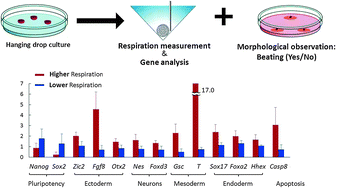Mouse embryoid bodies (mEBs) were evaluated in detail on the basis of respiratory activity and high-throughput quantitative reverse transcription-PCR (RT-qPCR) analysis. The hanging drop culture method was applied to prepare various sizes of mEBs ranging from 100 to 250 μm in radius by causing the aggregation of embryonic cells. The respiratory activity of individual mEBs was noninvasively measured using scanning electrochemical microscopy in a cone-shaped microwell. For gene expression analysis, we used 48.48 Dynamic Array chips (Fluidigm) integrating microfluidic circuits, which allowed high-throughput qPCR analysis in parallel. The respiratory activity of the mEBs that were cultured for 1 to 6 days could predict the mRNA levels of undifferentiation and differentiation markers. However, the sizes of the mEBs could also predict the gene expression of the undifferentiation/differentiation markers because the radii of the mEBs increased by more than 2-fold after incubation in hanging drop culture for 6 days. Next, mEBs with identical sample sizes were evaluated for respiratory activity and gene expression. For mEBs cultured at 1500 cells per droplet for 3 days, the respiratory activity was negatively correlated with the mRNA levels of pluripotent markers such as Nanog and Sox2. Many differentiation markers were positively correlated with the respiratory activity. However, there was no significant difference in respiration activity between the beating and nonbeating samples on day 3. Finally, principal component analysis (PCA) confirmed the relationship between respiratory activity and the mRNA levels of undifferentiation/differentiation markers.

You have access to this article
 Please wait while we load your content...
Something went wrong. Try again?
Please wait while we load your content...
Something went wrong. Try again?


 Please wait while we load your content...
Please wait while we load your content...